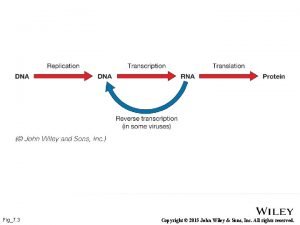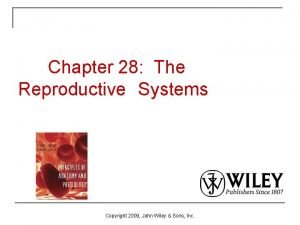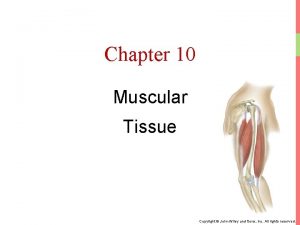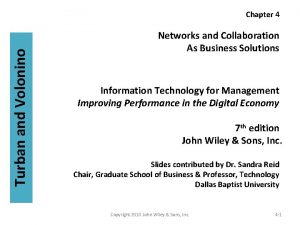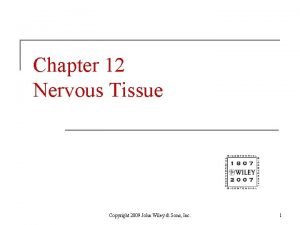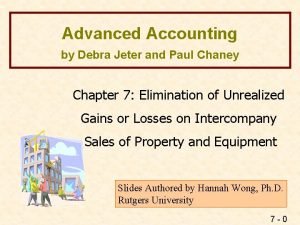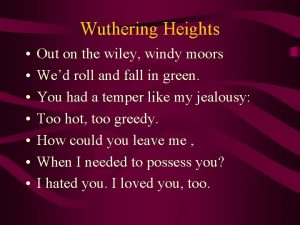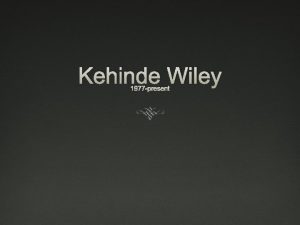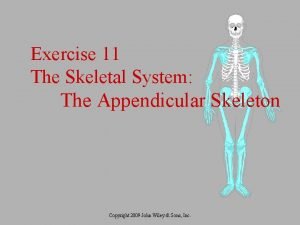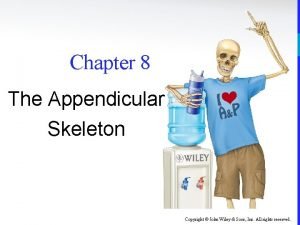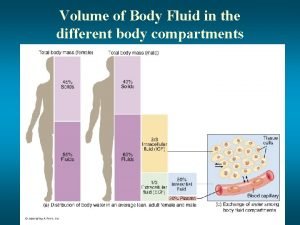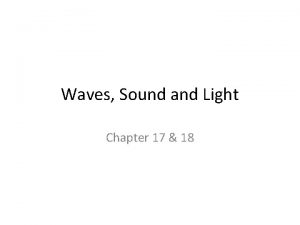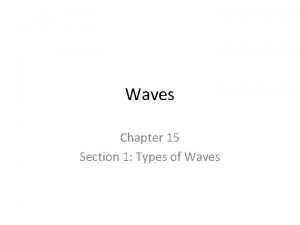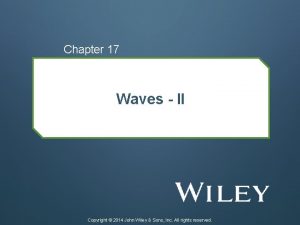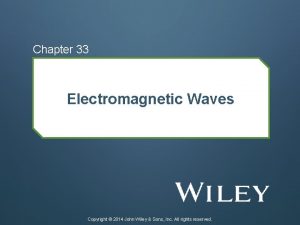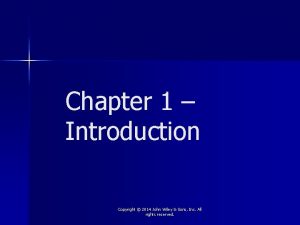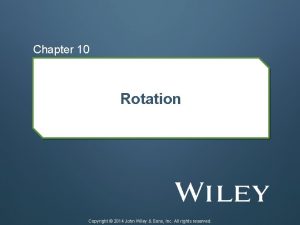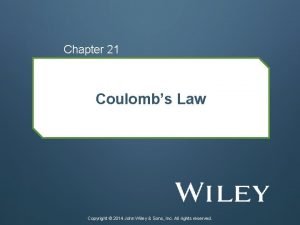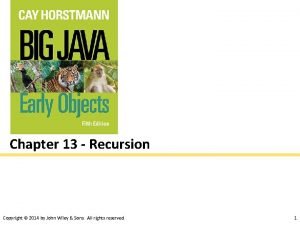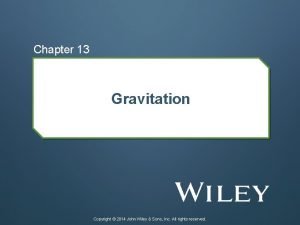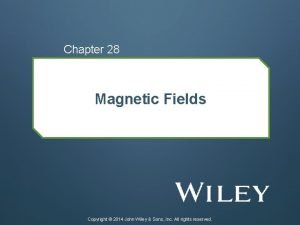Chapter 16 Waves I Copyright 2014 John Wiley














































- Slides: 46

Chapter 16 Waves - I Copyright © 2014 John Wiley & Sons, Inc. All rights reserved.

16 -1 Transverse Waves Types of Waves 1. Mechanical Waves: They are governed by Newton’s laws, and they can exist only within a material medium, such as water, air, and rock. Examples: water waves, sound waves, and seismic waves. 2. Electromagnetic waves: These waves require no material medium to exist. Light waves from stars, for example, travel through the vacuum of space to reach us. All electromagnetic waves travel through a vacuum at the same speed c = 299 792 458 m/s. 3. Matter waves: These waves are associated with electrons, protons, and other fundamental particles, and even atoms and molecules. Because we commonly think of these particles as constituting matter, such waves are called matter waves. © 2014 John Wiley & Sons, Inc. All rights reserved.

16 -1 Transverse Waves Transverse and Longitudinal Waves A sinusoidal wave is sent along the string (Figure (a)). A typical string element moves up and down continuously as the wave passes. This is transverse wave. A sound wave is set up in an air- filled pipe by moving a piston back and forth (Figure (b)). Because the oscillations of an element of the air (represented by the dot) are parallel to the direction in which the wave travels, the wave is a longitudinal wave. © 2014 John Wiley & Sons, Inc. All rights reserved. (a) Transverse Wave (b) Longitudinal Wave

16 -1 Transverse Waves Sinusoidal Function Five “snapshots” (y vs x each at a constant time) of a string wave traveling in the positive direction along an x axis. The amplitude ym is indicated. A typical wavelength λ, measured from an arbitrary position x 1, is also indicated. The sine function describes the shape of the wave © 2014 John Wiley & Sons, Inc. All rights reserved.

16 -1 Transverse Waves Period, Wave Number, Angular Frequency and Frequency © 2014 John Wiley & Sons, Inc. All rights reserved.

© 2014 John Wiley & Sons, Inc. All rights reserved.

16 -1 Transverse Waves The Speed of a Traveling Wave Two snapshots of the wave: at time t=0, and then at time t=Δt. As the wave moves to the right at velocity ν, the entire curve shifts a distance Δx during Δt. © 2014 John Wiley & Sons, Inc. All rights reserved.

© 2014 John Wiley & Sons, Inc. All rights reserved.

© 2014 John Wiley & Sons, Inc. All rights reserved.

© 2014 John Wiley & Sons, Inc. All rights reserved.

16 -2 Wave Speed on a Stretched String Learning Objectives 16. 14 Calculate the linear 16. 15 Apply the relationship density μ of a uniform string in between wave speed ν, tension terms of the total mass and total τ, and linear density μ. length. © 2014 John Wiley & Sons, Inc. All rights reserved.

16 -2 Wave Speed on a Stretched String Learning Objectives The speed of a wave on a stretched string is set by properties of the string (i. e. linear density), not properties of the wave such as frequency or amplitude. Tau is the tension (in N) in the string. (linear density) © 2014 John Wiley & Sons, Inc. All rights reserved.

© 2014 John Wiley & Sons, Inc. All rights reserved.

© 2014 John Wiley & Sons, Inc. All rights reserved.

16 -3 Energy and Power of a Wave Traveling along a String Learning Objective 16. 16 Calculate the average rate at which energy is transported by a transverse wave. © 2014 John Wiley & Sons, Inc. All rights reserved.

16 -3 Energy and Power of a Wave Traveling along a String • When we set up a wave on a stretched string, we provide energy for the motion of the string. As the wave moves away from us, it transports that energy as both kinetic energy and elastic potential energy. • The Rate of Energy Transmission The kinetic energy d. K associated with a string element of mass dm is given by where u is the transverse speed of the oscillating string element © 2014 John Wiley & Sons, Inc. All rights reserved.

16 -3 Energy and Power of a Wave Traveling along a String • The average power of, or average rate at which energy is transmitted by, a sinusoidal wave on a stretched string is given by The factors μ and ν in this equation depend on the material and tension of the string. The factors ω and ym depend on the process that generates the wave. © 2014 John Wiley & Sons, Inc. All rights reserved.

© 2014 John Wiley & Sons, Inc. All rights reserved.

© 2014 John Wiley & Sons, Inc. All rights reserved.

16 -4 The Wave Equation Learning Objective 16. 17 For the equation giving a string-element displacement as a function of position x and time t, apply the relationship between the second derivative with respect to x and the second derivative with respect to t. © 2014 John Wiley & Sons, Inc. All rights reserved.

16 -4 The Wave Equation By applying Newton’s second law to the element’s motion, we can derive a general differential equation, called the wave equation, that governs the travel of waves of any type. (a) A string element as a sinusoidal transverse wave travels on a stretched string. Forces and act at the left and right ends, producing acceleration with a vertical component ay. (a) The force at the element’s right end is directed along a tangent to the element’s right side. © 2014 John Wiley & Sons, Inc. All rights reserved.

16 -4 The Wave Equation This is the general differential equation that governs the travel of waves of all types. Here the waves travel along an x axis and oscillate parallel to the y axis, and they move with speed v, in either the positive x direction or the negative x direction. © 2014 John Wiley & Sons, Inc. All rights reserved.

16 -5 Interference of Waves Learning Objectives 16. 20 Describe how the phase difference between two 16. 18 Apply the principle of transverse waves (with the superposition to show that two same amplitude and overlapping waves add wavelength) can result in algebraically to give a fully constructive resultant (or net) wave. interference, fully destructive 16. 19 For two transverse waves interference, and with the same amplitude and intermediate interference. wavelength and that travel together, find the displacement 16. 21 With the phase equation for the resultant wave difference between two interfering waves expressed and calculate the amplitude in in terms of wavelengths, terms of the individual wave quickly determine the type of amplitude and the phase interference the waves have. difference. © 2014 John Wiley & Sons, Inc. All rights reserved.

16 -5 Interference of Waves Principle of Superposition of waves Let y 1(x, t) and y 2(x, t) be the displacements that the string would experience if each wave traveled alone. The displacement of the string when the waves overlap is then the algebraic sum This summation of displacements along the string means that © 2014 John Wiley & Sons, Inc. All rights reserved.

© 2014 John Wiley & Sons, Inc. All rights reserved.

16 -5 Interference of Waves The resultant wave due to the interference of two sinusoidal transverse waves, is also a sinusoidal transverse wave, with an amplitude and an oscillating term. © 2014 John Wiley & Sons, Inc. All rights reserved.

© 2014 John Wiley & Sons, Inc. All rights reserved.

16 -5 Interference of Waves Constructive and Destructive Interference Two identical sinusoidal waves, y 1(x, t) and y 2(x, t), travel along a string in the positive direction of an x axis. They interfere to give a resultant wave y’(x, t). The resultant wave is what is actually seen on the string. The phase difference Φ between the two interfering waves is (a) 0 rad or 0 o, (b) π rad or 180 o, and (c) 2/3 π rad or 120 o. The corresponding resultant waves are shown in (d), (e), and ( f ). © 2014 John Wiley & Sons, Inc. All rights reserved.

© 2014 John Wiley & Sons, Inc. All rights reserved.

© 2014 John Wiley & Sons, Inc. All rights reserved.

© 2014 John Wiley & Sons, Inc. All rights reserved.

16 -6 Phasors Learning Objectives 16. 24 By using phasors, find the resultant wave of two transverse waves traveling together along a string, calculating the amplitude and phase and writing out the 16. 23 Sketch a phasor diagram displacement equation, and for two overlapping waves then displaying all three traveling together on a string, phasors in a phasor diagram indicating their amplitudes and that shows the amplitudes, phase difference on the sketch. the leading or lagging, and the relative phases. 16. 22 Using sketches, explain how a phasor can represent the oscillations of a string element as a wave travels through its location. © 2014 John Wiley & Sons, Inc. All rights reserved.

16 -6 Phasors A phasor is a vector that rotates around its tail, which is pivoted at the origin of a coordinate system. The magnitude of the vector is equal to the amplitude ym of the wave that it represents. (a) (b) (a) A second phasor, also of angular speed ω but of magnitude ym 2 and rotating at a constant angle β from the first phasor, represents a second wave, with a phase constant Φ. (b) The resultant wave is represented by the vector sum y’m of the two phasors. © 2014 John Wiley & Sons, Inc. All rights reserved.

16 -7 Standing Waves and Resonance Learning Objectives 16. 25 For two overlapping waves (same amplitude and wavelength) that are traveling in opposite directions, sketch snapshots of the resultant wave, indicating nodes and antinodes. calculate the amplitude in terms of the individual wave amplitude. 16. 27 Describe the SHM of a string element at an antinode of a standing wave. 16. 26 For two overlapping waves (same amplitude and wavelength) that are traveling in opposite directions, find the displacement equation for the resultant wave and © 2014 John Wiley & Sons, Inc. All rights reserved.

16. 28 For a string element at an antinode of a standing wave, write equations for the displacement, transverse velocity, and transverse acceleration as functions of time. 16. 29 Distinguish between “hard” and “soft” reflections of string waves at a boundary. 16. 30 Describe resonance on a string tied taut between two supports, and sketch the first several standing wave patterns, indicating nodes and antinodes. 16. 31 In terms of string length, determine the wavelengths required for the first several harmonics on a string under tension. 16. 32 For any given harmonic, apply the relationship between frequency, wave speed, and string length. © 2014 John Wiley & Sons, Inc. All rights reserved.

16 -7 Standing Waves and Resonance Standing Waves The interference of two identical sinusoidal waves moving in opposite directions produces standing waves. For a string with fixed ends, the standing wave is given by Stroboscopic photographs reveal (imperfect) standing wave patterns on a string being made to oscillate by an oscillator at the left end. The patterns occur at certain frequencies of oscillation. © 2014 John Wiley & Sons, Inc. All rights reserved.

© 2014 John Wiley & Sons, Inc. All rights reserved.

© 2014 John Wiley & Sons, Inc. All rights reserved.

© 2014 John Wiley & Sons, Inc. All rights reserved.

© 2014 John Wiley & Sons, Inc. All rights reserved.

© 2014 John Wiley & Sons, Inc. All rights reserved.

© 2014 John Wiley & Sons, Inc. All rights reserved.

© 2014 John Wiley & Sons, Inc. All rights reserved.

16 -7 Standing Waves and Resonance Harmonics Standing waves on a string can be set up by reflection of traveling waves from the ends of the string. If an end is fixed, it must be the position of a node. This limits the frequencies at which standing waves will occur on a given string. Each possible frequency is a resonant frequency, and the corresponding standing wave pattern is an oscillation mode. For a stretched string of length L with fixed ends, the resonant frequencies are © 2014 John Wiley & Sons, Inc. All rights reserved.

16 Summary Wave Speed Waves Transverse Waves Longitudinal Waves Angular velocity/ Angular wave number Eq. (16 -13) Sinusoidal Waves Traveling Waves Wave moving in positive direction (vector) A functional form for traveling waves Eq. (16 -2) © 2014 John Wiley & Sons, Inc. All rights reserved. Eq. (16 -17)

16 Summary Standing Waves Powers Average Power is given by The interference of two identical sinusoidal waves moving in opposite directions produces standing waves. Eq. (16 -33) Eq. (16 -60) Interference of Waves Two sinusoidal waves on the same string exhibit interference Eq. (16 -51) Resonance For a stretched string of length L with fixed ends, the resonant frequencies are Eq. (16 -66) © 2014 John Wiley & Sons, Inc. All rights reserved.
 John wiley & sons
John wiley & sons John wiley & sons
John wiley & sons Wiley
Wiley John wiley & sons, inc.
John wiley & sons, inc. Organic chemistry
Organic chemistry John wiley
John wiley John wiley and sons
John wiley and sons 2014 pearson education inc
2014 pearson education inc Mechanical waves and electromagnetic waves similarities
Mechanical waves and electromagnetic waves similarities Light and sound travel in waves true or false
Light and sound travel in waves true or false Mechanical waves and electromagnetic waves similarities
Mechanical waves and electromagnetic waves similarities Differences between mechanical and electromagnetic waves
Differences between mechanical and electromagnetic waves The wave chapter 13
The wave chapter 13 Sound is a longitudinal wave
Sound is a longitudinal wave Long waves and short waves
Long waves and short waves Mechanical waves and electromagnetic waves similarities
Mechanical waves and electromagnetic waves similarities Mechanical waves vs electromagnetic waves
Mechanical waves vs electromagnetic waves Mechanical waves and electromagnetic waves similarities
Mechanical waves and electromagnetic waves similarities Surface waves and body waves
Surface waves and body waves Is a seismic wave mechanical or electromagnetic
Is a seismic wave mechanical or electromagnetic Compare and contrast p waves and s waves using venn diagram
Compare and contrast p waves and s waves using venn diagram Mechanical waves vs electromagnetic waves venn diagram
Mechanical waves vs electromagnetic waves venn diagram Constructive waves and destructive waves difference
Constructive waves and destructive waves difference Onlinelibrary.wiley
Onlinelibrary.wiley Jean butler genie
Jean butler genie Debra jeter
Debra jeter Genie wiley
Genie wiley What do the moors symbolize in wuthering heights
What do the moors symbolize in wuthering heights Water reabsorption
Water reabsorption Kehinde wiley bio
Kehinde wiley bio Mis chapter 9
Mis chapter 9 Chris ofili afrodizzia
Chris ofili afrodizzia Rist bone
Rist bone Onlytoc
Onlytoc Pectoral girdle
Pectoral girdle Ward v. wilbanks
Ward v. wilbanks Wiley
Wiley Metabolic waste
Metabolic waste Pancreas
Pancreas Chemical reactions of alkynes
Chemical reactions of alkynes Flykda
Flykda Wiley
Wiley Wiley
Wiley Cochrane wiley
Cochrane wiley Wiley
Wiley Chapter 17 mechanical waves and sound wordwise answer key
Chapter 17 mechanical waves and sound wordwise answer key Chapter 15 section 1 types of waves answers
Chapter 15 section 1 types of waves answers
